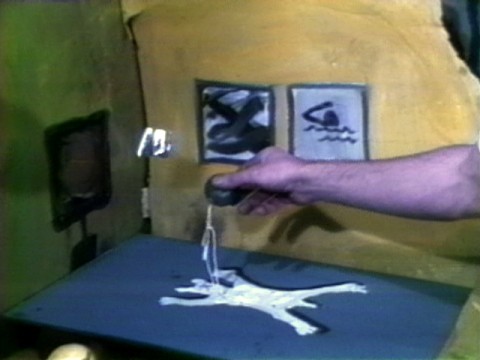Over the course of a career that began in the early 1980s, Tony Oursler has developed an influential and idiosyncratic aesthetic. He has created single-channel videos involving elaborate sets, three-dimensional installations animated by moving images and sound, collaborative multimedia projects, and outdoor projections that enliven inanimate structures. These diverse works are part expressionist, part makeshift do-it-yourself, part techno-savvy, and entirely Oursler’s own. Oursler’s unique approach was evident in his earliest pieces—hermetic, narrative videos that the native New Yorker began producing after returning to his home state following studies at the California Institute of the Arts (BFA, 1979). There he studied with exuberant painter Judy Pfaff and cool conceptual artist John Baldessari, two people who may have influenced his engagement over the next decade with the tradition of craft and with current technology.
By the early 1990s, Oursler had moved away from single-channel videos and began exploring the psychodrama of human relationships by projecting moving faces onto talking “dummies” arranged into installations. These installations are among his best-known works and include _Let’s Switch_ (1996), which features a pair of calico-clad rag dolls. The two dolls stand arm-in-arm, each with an oversized cloth head onto which a prerecorded video of a face is projected. A soundtrack reveals the pair’s complicated relationship. One says “I’d like to rip down the wall between us,” and the other retorts “I have parts of me I’ve never been introduced to.” The mysterious dialogue continues, remaining psychologically charged yet never cohering into a narrative.
While Oursler’s early videos have a more linear quality, they similarly frustrate expectations that a narrative be easy to comprehend. Rather, in works such as _The Weak Bullet_ (1980), the artist creates a childlike inner world that engages issues of morality and storytelling, interests which the artist traces to his family’s background in editing, publishing, and writing children's and religious books. The thirteen-minute-long videotape _Weak Bullet_ has a rough quality that contrasts with the polished aesthetic found in the stories we are accustomed to seeing on television. In Oursler’s tale, the video camera rambles through a variety of crudely painted and crafted cardboard sets dotted with props animated by people who are sometimes visible. A voice off-camera whispers, shouts, and cackles the story, which revolves around a bullet alternately played by a gloppy clump of clay, a hand-drawn cardboard casing, and a cylinder attached to string. The bullet wreaks havoc when it sprouts from a child’s imaginary game and improbably travels through various buildings, people, animals, and objects. Along the way it knocks over a cow made out of a tin can and a banana, lights afire a telephone wire composed of yarn, and smashes a pair of testicles fashioned out of eggs. The story ends when it impregnates a coarsely constructed lady. _The Weak Bullet_ is Oursler’s contemporary take on a hundred-year-old tale. In the work he is playing with an apocryphal Civil War-era story about a bullet that spawned a child after traveling through a man’s scrotum and into a woman’s ovaries. From the seeds of the original narrative the artist weaves a new and zanier one using his signature handcrafted style and the latest video technology. In _The Weak Bullet_, Oursler demonstrates the complexity of storytelling. He shows that while stories may be constantly recycled, each time and with each teller, they become almost brand new. _—Kate Green_

